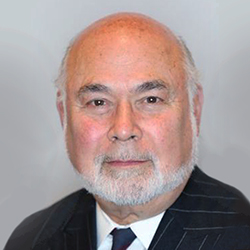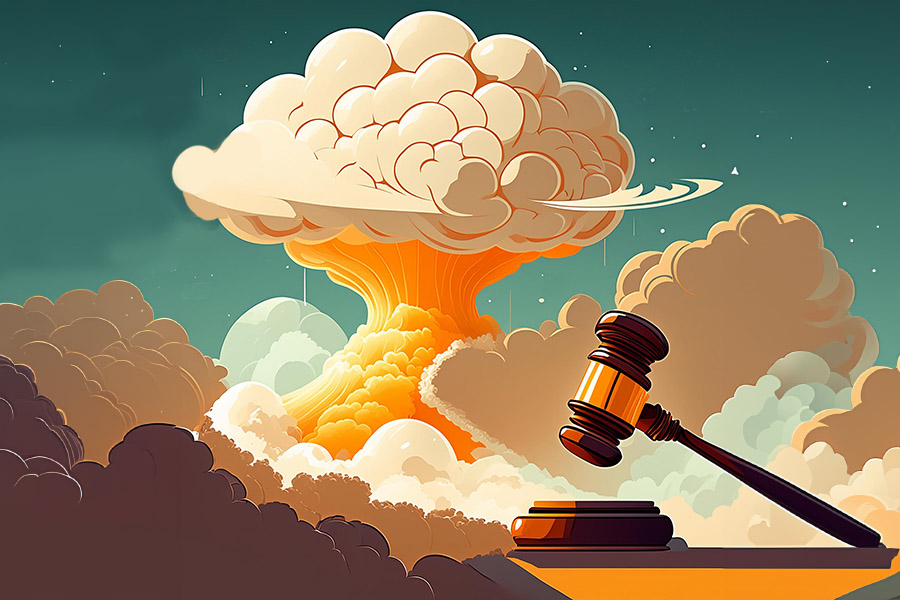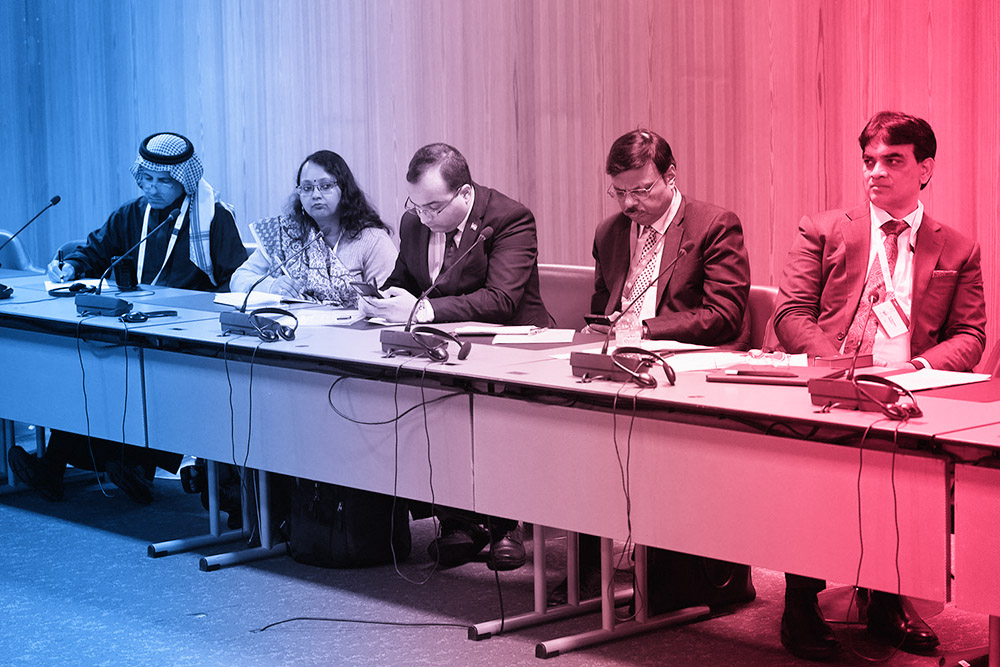Reflections and Policies for Human Unity
By Jonathan Granoff
President, Global Security Institute
Interfaith Council of Greater Sacramento California
May 2, 2019
It is an honor to address on of America’s if not the world’s oldest most successful interfaith organizations. I believe we share an appreciation for Saadi, the Persian poet of the 13th century, who sang:
The human family is one body with many parts
Creations arising from one unseen essence
Any harm to any part summons an awakening
a dis-ease and a healing response from all parts
You who fail to feel the pain of others cannot be called truly human.
On the Casuarian Coast in the flat mangrove swampland of Indonesian New Guinea, where water and land intermingle with a rhythmic ebb and flow, a tribe of about 20,000 people live in harmony with the environment. They call themselves the Asmat, “the people — the human beings.” Everyone else is called Manowe, “the edible ones.” Until very recently they were proud to be cannibals. The Asmat do not organize for total war. Their killing practice is ritualized, limited and controlled.
We ignore at our peril the fact that the civilized nations of the world since World War II have spent astronomical fortunes, in excess of ten trillion since the end of the Cold War alone, organizing killing apparatus capable of destroying all life on the planet many times over. Today, conflicts rage in over twenty killing fields driven by religious, ethnic and racial bigotry. In good conscience religions permits these horrors where the vast majority of victims are innocent women and children — noncombatants.
Coupled with weapons of mass destruction, this modern capacity for organized carnage, if guided by religious bigotry, could easily lead to the unspeakable. This makes us all “edible ones”. Al Qaida utilizes religious symbols and language in its attempts to rationalize its crimes against humanity. Such abuse is certainly not new and has occurred in many guises. For example, Europe suffered population decimation through thirty years of chaos when Protestants and Catholics slaughtered each other between 1618 and 1648. The Treaty of Westphalia, in which the basis of the modern nation state system was formally established, deftly divested political process from the capacity of religions to stimulate endless war. What Europe experienced in the 17th Century cannot be tolerated on a global scale with today’s technologies.
In the face of current challenges, many recognize a growing global awareness of the power of universal compassion nested within each religious tradition, and this awareness does not diminish the knowledge that each tradition has the ability to dehumanize and destroy the “other” either by conversion or genocide. We come together as a human community when we awaken the unity expressed by Saadi in the quest to fulfill our own humanity. For us who are aware of the power of universal compassion, for us, there are no “edible ones.”
Threats and Solutions
We cannot ignore the dangers inherent in the use of force outside international legal constraints coupled with a culture of violence and fear. We simply must commit to promoting a culture of peace founded on the rule of law, the dignity of our higher qualities, and deeper dialogue amongst peoples to bring us back on track.
The greatest threat that faces humanity might be understood as the indifference toward extraordinary human suffering from poverty, environmental practices that ignore our responsibility to future generations, thus to degrade the natural world upon which their lives will depend and the willingness to threaten the use of nuclear weapons. This indifference indicates a failure of caring for life, a failure of love. Its severe consequence is political apathy toward critical issues and a reversion toward nationalism, violence, provincialism and prejudice. This indifference must be overcome by an awakening of our capacity to learn to live together as one human family.
It is now common knowledge that for the human community to survive we must live in harmony with the natural world. This ecological consciousness can be taught, universally and effectively. We must now learn that coexistence between and amongst peoples can be taught, universally and effectively. The old model of competitive and dialectical discourse where one attempts to refute the claims of the other must now grow into a new model of cooperation and dialogue.
One crucial step will be the promotion of interfaith and intercultural understanding through the institutionalization of forums for dialogue. Interfaith initiatives bring the deep values of each participating faith into action and actually deepens that faith traditions capacity to uplift and expand hearts.
Scriptures of the major religions, from the Bhagvad Gita, to the Bible and the Quran, are replete with explicitly acceptable violence as well as admonitions upon which to base universal love, justice and appreciation. We must continually find ways of institutionalizing the loving dimensions so that “loving ones neighbor as oneself” can become the norm. In the Quran (Sura 49:13) we find “O humanity, God has created you male and female, and has made you nations and tribes that you may know one another. The noblest of you before God is the one with deep piety and good deeds. Behold God is all knowing and all aware.” How can such directions be fulfilled unless we really come to know each other?
We need not come to agreement about theology in order to seek mercy and justice. Why should there be fear of the “tribe” with whom we might disagree? Abraham, with the most profound insight into the nature of justice and as an example of fulfilled humanity, pleaded passionately for mercy for those with whom he did not agree — the people of Sodom and Gomorrah. We need not agree on theology to address cooperatively the global crises of human rights, justice, poverty, hunger, ecological destruction and nuclear annihilation. Compassion and helping those in need are universally recognized spiritual principles. We need to communicate to learn this.
Who is the beneficiary of today’s Good Samaritan and to whom do we owe a sense of responsibility in an interconnected world? Why should the Imam not visit the temple and share and the Rabbi not visit the mosque and share? Will someone be diminished or confused? Why should the priest not share with the minister? How else will we really learn what is profoundly held as truth by our neighbor so that we might love one another?
The contemporary Sufi master Bawa Muhaiyaddeen often said: “Separate from yourself that which separates you from other lives.” The same qualities that separate us from other lives — such as anger, fanaticism, falsehood, pride, jealousy, greed, hatred, hastiness — separate us from the immeasurable power of goodness beyond name, gender and form that many call God. The same qualities that bring harmony with other lives — such as, love, compassion, tolerance, peacefulness, patience — bring us into harmony with our self and its source. That harmony ultimately awakens wisdom, which can investigate the meaning of our lives. How glorious, unifying and full of justice is this mystery known only to those who open their hearts to lives other than their own.
If we do not learn such principles of harmony and put them into practice, we face a world ruled by the law of power, rather than the power of law; a world ruled by the love of power, rather than the power of love.
Pride of Power
Nuclear weapons represent a form of security apartheid. Like apartheid, both sides are injured. Those threatened reasonably feel the terror of destruction. Those threatening have their moral foundations corroded or live in denial of what they are doing. The continued reliance on these horrific devices provides the modern world with its most severe and divisive irony. The means of pursuing security are serving to breed insecurity. And the inequity inherent in the system pulls at the fabric of human unity. As Vartan Gregorian of the Carnegie Corporation recently pointed out, “All declared nuclear powers – the US, Russia, Great Britain, France, and China and now India and Pakistan (Israel in an undeclared nuclear power) – insist they possess nuclear weapons only to deter others from using them. Yet there have been many times in the past, and there will surely be times in the future, when major powers have used their nuclear capability to gain some political end by intimidation.”
Intimidation through the threat of annihilation of millions of innocent people is unjustified legally, morally, and remains the greatest threat to the stimulation of the proliferation of weapons. Thus, continued threat to use these weapons is impractical. One must therefore wonder if the irrational pride of power informs the policies of those who seek to perpetuate and “improve” their arsenals of devastation. One must wonder if the club of possessing states consider themselves somehow superior, a bizarre form of technological pride. If this pride mixes with religious pride, annihilation in the pursuit of religious purity becomes an imminent possibility. Nationalism can become like a religion. We live in a very dangerous time.
Pride of Religious Exclusivity
The mystery of the source of life and creation itself from which we come, toward which we return and in and through which we live and are sustained cannot be measured nor can it be fully described by symbols or the intellect. In fact, even the great religions are only means of honoring, remembering and describing – sacred metaphors – but not the actual reality itself. Thus, exclusivity based on the elegance of the metaphors does an injustice to the primacy of the unbounded foundation. The founders of the world’s great faiths reached out with good news and a universal embrace, particularly holding the outcast, the downtrodden, the rejected – quite the opposite of today’s exclusivists.
Today’s exclusivists have turned their backs to the power of the original embrace of love and compassion upon which each of their traditions rests. This attitude is caused by ignorance, fear and arrogance. It leads to the quest for unlimited power based on insecurity. Exclusivism cannot effectively open hearts, a precondition of the wisdom needed to understand the divine mystery, nor address adequately the three evil dynamics of this modern age – unnecessary pandemic poverty, irresponsible selfishness that leads to environmental degradation, and the irrational hazardous reliance on the threat to use nuclear weapons as a means of pursuing security.
On the contrary exclusivism will only exacerbate our present inadequate levels of cooperation. Its main characteristic is the belief, “Our way of thinking and pursuing reality is the only good way.” What does it mean to say that the way to the Father is through Jesus unless His quality of love is pursued? What does it mean to be one of the Chosen People without treating one’s neighbor as one wishes to be treated? What does it mean to follow the dharma without seeking refuge in the power of compassion? What does it mean to honor Allah without affirming the quality of mercy by which He is known? The characteristic of the founders of each faith has been extraordinary, immeasurable kindness, mercy, compassion, love and wisdom.
Many exclusivists actually believe that the divine only has ears for their language. Others believe that his messenger(s) require a building at a particular location in order to save souls. Others believe that establishing real estate boundaries is more important than cultivating love and understanding. They are incapable of imagining that blessings can be universal. They all believe that their method of explaining the origins of the universe and the end of days are the only true way. Although none of them have ever actually seen the creation of their holy scripture they all believe that it is the unique word of truth and that all others are wrong. Many are willing to kill for their ideas about the divine mystery and many others are willing to die for these ideas. Few have experienced, integrated and are capable of sharing divine love, mercy, or compassion. All have strongly held ideas.
Exclusivism is most dangerous in the potential short-term political advantage that its passions can provide to a political leader. Imagine the temptation to politicians to cater to the mythology that exclusivists propound? Imagine what can happen in a modern state with global influence when its leaders are identified with such passions? Imagine the dangers if leaders in a country with weapons of mass destruction become subject to the interests of exclusivists in their society?
Even if a person believes a stone is the Lord, their beliefs should pose no concern to the political order; however, if they want to throw the stone or condemn those who believe the Lord is formless, then concern is warranted. Likewise, those who believe God is formless and want to stone those who believe in stones can hardly be considered models of mercy, love and compassion. It is not the fundamental beliefs of any religion that is a problem; it is the exclusivist arrogance of those who use religion to acquire power over others that is the problem.
The quest to enforce any one faith that derogates all other beliefs will surely fracture the peace of the world. The capacity to use religious faith to dehumanize others coupled with modern technologies of killing presents an unacceptable risk. We simply cannot ignore this risk.
Hot Spots
Every day in the news we can always find a crisis in which religious bigotry helps fan flames. Today we can see it in Israel and Gaza. Tomorrow who knows where ignorance will be a tool for abusing someone, some people, some nation?
Without even addressing the extremely hot conflict over real estate in Jerusalem, where exclusivists in three faiths believe that the Savior of humanity requires their group to possess a particular piece of real estate (the present location of the Dome of the Rock where the Temple of Solomon used to be located) in order to save humanity, it is easy to see numerous extremely volatile regions flamed recently by religious distortions. Let’s just list a few:
Cote d’Ivoire: Muslims, Indigenous, and Christian
Cyprus: Christians and Muslims
East Timor: Christians and Muslims
India: Animists, Hindus, Muslims, and Sikhs
Indonesia, Ambon and Halmahera: Christians and Muslims
Kashmir: Hindus and Muslims
Kosovo: Serbian Orthodox Christians and Muslims
Macedonia: Macedonian Orthodox Christians and Muslims
Nigeria: Christians, Animists, and Muslims
Northern Ireland: Protestants and Catholics
Pakistan: Sunni and Shiite Muslims
Philippines: Christians and Muslims
Russia, Chechnya: Russian Orthodox Christians and Muslims
South Africa: Various Animists
Sri Lanka: Buddhists and Hindus and Muslims
Sudan: Animists, Christians, and Muslims
United States: Fill in the blanks.
In most instances, civilian populations are terrorized. In most of the instances where these conflicts are in the developing world, there is a history of fortunes squandered through the purchase of weapons, almost exclusively from one of the five permanent members of the UN Security Council – US, Russia, France, UK, or China. In each of these cases, killing has been performed in good conscience, with the blessings of religious figures.
Thousands were needlessly killed at the World Trade Center. But, what about little Rwanda, a tragedy of epic proportion which could have been stopped? What about Myanmar? These tragedies could have been prevented had there been concerted efforts to bring intercultural understanding into the lives of the people in a systematic and sustained fashion. It could have been prevented had there been a political will to look at the depth of the hatred and address it squarely. The risks of tribalism, like religious exclusivism, must not be ignored.
The events of 9/11 demonstrated that low technology can be leveraged to cause tremendous injury and the risks of tribalism, whether ethnic or religious, cannot be permitted to overtake the world. The situation takes on urgency for those who pay attention to the tons of nuclear materials in existence. Yet, we cannot throw up our hands and surrender the future to a world riddled with untenable risk, where identity politics could drive us into an abyss the horror of which Dante alone could describe. Can we expect unilateral militarism of one superpower to save us? Can we sit back and watch a slow descent into new fault lines of religious bigotry? Do we have any choice but to strengthen multilateral cooperation for security building based on the rule of law?
A step toward that level of cooperation would be demonstrated if Russia and the US would take the lead in moving toward a world without nuclear weapons and addressing addiction to fossil fuels. These tasks remain outstanding regardless of qualities of these nations leaders or competencies.
We can and must establish institutional structures to systematically address prejudice and hatred and build a culture of peace. We must demonstrate at a public level that interfaith understanding is to be promoted.
Conclusion
By finding ways of promoting openly the process of interfaith appreciation, the quiet study of our common humanity is stimulated. One of the greatest gifts received by the open hearted is the gratitude of being part of the human family, a sense of joy in its variety of expressions of awe, love, and the sacred. Those who have this sense of gratitude are the ones who can step forward to assert our common ground, the place where exclusivism and fanaticism cannot flourish. Where our common humanity is affirmed and love expressed, fear, the breeding ground for fanaticism, is overcome. Where our common humanity is affirmed, the precondition for justice is established. Justice is the foundation for peace. Where fanaticism is allowed to grow, where grievances find no peaceful means of redress, where people demonize innocents who do not believe as they do, catastrophe follows.
Clearly, where compassion leads to actions that give hope based on a sense of justice without regard to religion, race or national situation, the environment where visions based on hate, hopelessness and fear will be dried up. Let us be warned and plant places where our higher nature is affirmed.
Whether garbed in extremist political ideology, racial of tribal identity, or religious dogma, the exclusivist’s vision diminishes our common capacity to work cooperatively, reason together, identify our common interests and establish rules and laws of governance. The successes of the modern world have demonstrated that Hobbes, who believed life to be short, brutish and nasty, was trumped by Locke and his philosophical stepson Jefferson, who viewed our fate with the faith that we are blessed with inalienable rights, regardless of our religious beliefs, that no state can remove and that we are capable of establishing institutions to protect those rights. This optimistic view is the basis of the United States, the Universal Declaration of Human Rights, and the UN System. It challenges all fanatics who deny civilized give and take. A first step to discover that all people possess such human capacities is through direct interfaith interaction.
We no longer have the luxury of living in religious ghettos. We must come into the open space of our greater humanity and assert the highest ideals that the founders of every faith proclaimed: “Love thy neighbor as thyself.” Our humanity is revealed the deeper we realize and live this admonition.
Let me conclude with two quotes. The first is obviously informed by spiritual experience, while the second arises from a man with unassailable scientific credentials.
Bawa Muhaiyaddeen:
If each of you will open your heart,
your actions, your wisdom, and your conduct and look within,
you will see that every face is your face,
every nerve is your nerve, each drop of blood is your blood,…
all hunger is your hunger, all poverty is your poverty…all lives are your life. You will experience this in your nerves, in your body and in what you see. When that state develops inside you, that is God’s love… If that love develops you will not hurt any other living thing, you will not cause pain, you will not reject any life,
and you will not torture any other life, because if you hurt anyone it will hurt you.”
-Book of Gods’ Love, p.23.
Albert Einstein:
Oh Youth:
Do you know that yours is not the first generation to yearn for a life full of beauty and freedom?
Do you know that all your ancestors have felt the same as you do –
and fell victim to trouble and hatred?
Do you know also that your fervent wishes can only find fulfillment
if you succeed in attaining a love and understanding of people,
and animals, and plants, and stars, so that every joy becomes your joy and every pain becomes you pain?”
Quoted in David and Beatrix Hamburg’s comprehensive work,
– Learning to Live Together, p. 363.
Appendix A – Fact Sheet
Global Challenges, Threats to Humanity
These threats all share a common characteristic. To solve them greater levels of cooperation are required and religious and ethnic bigotry must be overcome to achieve success. Achieving the universal nondiscriminatory legally verifiable elimination of nuclear weapons, protecting the global environmental commons, and ending poverty are all public goods of the highest value.
Poverty
*Despite progress towards meeting the Millennium Development Goals, about one billion people will still live in extreme poverty.
*780 million people lack access to clean water. 3.4 million people die each year from a water-related disease.
* Women spend an estimated 200 million hours each day collecting and carrying water. That’s the equivalent of building 28 Empire State Buildings every day.
*1.8 million people die every year from diarrheal diseases; 90% of these deaths are children under five years old.
* Of the 67 million primary-school-age children who are not enrolled in school, 53 percent are girls. Of the lower secondary out-of-school adolescents, 52 percent are girls.
Nuclear Weapons (see also Appendix B)
*There are approximately 14,900 nuclear weapons in the world.
*Over 95% of them are in the hands of Russia and the United States. Of these, many remain on high alert status just as they were at the height of the Cold War.
* The United States is on track to spend between over $1.7 Trillion modernizing its arsenal.
*There are five declared nuclear weapon States: the United Kingdom, China, France, Russia, and the United States. Additional States that have acquired nuclear weapons over the past fifty years include India, Israel, Pakistan, and North Korea.
*The International Atomic Energy Agency (IAEA) estimates that a total of 44 countries presently possess the resources and technology to develop nuclear weapons, and that another 60 States could become capable doing so in the near future.
* Despite many legal and political obligations to reduce and ultimately eliminate existing nuclear arsenals, the nuclear weapon States are engaging in expensive modernization programs that will ensure the continuity of their nuclear arsenals for decades to come.
Military Spending
*World military expenditures in 2018 was more than $1.74 trillion—or $2.94 billion each day.
*James Wolfensohn, former President of the World Bank said on May 23, 2004 at his commencement address at Brandeis University: “You young people should understand that the way the world is spending its money today. We are spending $900 billion a year on military expenditures, $350 billion a year on agricultural subsidies, which affect developing countries adversely, and maybe $50 to $60 billion a year on development. We should be spending $900 billion on development, and then we would only need $50 billion on military expenditures.”19
Climate Change
*Global sea level rose about 6.7 inches in the last century. The rate in the last decade is nearly double that of the last century.
*Since the beginning of the Industrial Revolution, the acidity of surface ocean waters has increased by about thirty percent. This increase is the result of humans emitting more carbon dioxide into the atmosphere and hence more being absorbed in the oceans. The amount of carbon dioxide absorbed by the upper layer of the oceans is increasing by about two billion tons per year.
*China and the United States are by far the biggest contributors to carbon dioxide emissions, with 23.53% and 18.27% of the world’s total emissions, respectively. The European Union is in third place, with 13.98%. India and Russia, with 5.83% and 5.72% compete for a distant fourth place.
Deforestation
*While forests still cover about thirty percent of the world’s land area, swaths the size of Panama are lost each and every year. The world’s rain forests could completely vanish in a hundred years at the current rate of deforestation.
*Tropical forests in Latin America disappear at a rate of 2 percent per year. In Africa, the pace is about 0.8 percent per year, and in Asia it is 2 percent per year.
Appendix B – Fact Sheet
Why Nuclear Weapons remain a deadly threat.
About the bomb. The most devastating arms known to humankind, nuclear weapons derive enormous explosive power from a nuclear reaction. A fission reaction releases energy by splitting atoms of uranium and plutonium (known as fissile material). The only two nuclear bombs ever used in conflict, dropped by the United States on the Japanese cities of Hiroshima and Nagasaki in 1945, were fission weapons employing uranium and plutonium, respectively. In the 1950s the United States and the Soviet Union developed hydrogen weapons, which use a fission reaction to drive a fusion process, and release an explosive power many times that of their fission brethren: while the Hiroshima blast had explosive power equivalent to fifteen kilotons (15,000 tons) of TNT, some fusion weapons are on the magnitude of twenty megatons (20,000,000 tons) of TNT, making them more than 1,300 times more powerful. Less than 200 nuclear weapons could cause a nuclear winter rendering civilization untenable. Credible estimates place the number of nuclear weapons required to destroy Russia at 50 and the US at 120.
The effects of a nuclear weapon. Comparisons with TNT are incomplete, since in addition to the blast effect, a nuclear weapon releases thermal and nuclear radiation. Thermal radiation scorches exposed parts of the body and can ignite devastating fires over a wide radius. Nuclear radiation, which results from the neutrons and gamma rays associated with fission, is lethal in high doses, and has many insidious and lingering effects, including increased cancer rates and organ damage. A large-scale exchange would threaten the very existence of the human species. According to an analysis in the May 31, 1962 New England Journal of Medicine, if one 20 megaton bomb were dropped on a city such as Boston, almost 2.5 million people would be killed. Deaths from a full nuclear exchange, even one targeted at military facilities, would be exponentially greater. In a potential phenomenon known as “nuclear winter”, the debris raised by multiple nuclear explosions and the resulting fires could effectively block out the sun, gradually choking off life as we know it.
Senator Alan Cranston emphasized that a peace based on the threat to use these devices is unworthy of civilization, constituting a kind of terrorism. In less than fifteen minutes the leader of Russia or the US must verify an incoming attack, consult advisors and give orders, if computers notify him that there may be an attack. Several accidents put us on the brink of accidental nuclear war. According to the US Navy, the number of accidents, malfunctions, and false alarms is in the hundreds. For example, in January of 1995 Russian radar mistook a weather satellite for a Trident launch and placed its President in an unacceptably risky position for about ten minutes.
Nuclear weapons, ethics, and law. The willingness to utilize a weapon that cannot distinguish between civilians and combatants is morally and legally problematic. In 1996, the International Court of Justice ruled that the threat or use of nuclear weapons is generally illegal, and that states have an obligation to conclude negotiations on their elimination. The Holy See has said that nuclear weapons “cannot be justified. It is increasingly accepted that the use and threat of use of nuclear weapons are in violation of international humanitarian law. The International Court of Justice ruled, in 1996, that “the threat or use of nuclear weapons would generally be contrary to the rules of international law applicable in armed conflict, and in particular the principles and rules of humanitarian law.”
The danger of hair-trigger alert. Even today, US and Russian leaders have 15 minutes from the time a computer senses a possible attack to verify the incoming attack, consult advisors and give orders to strike with a nuclear weapon before their own arsenals are hit. Several accidents put us on the brink of accidental nuclear war. According to the US Navy, the number of accidents, malfunctions, and false alarms is in the hundreds. For example, in January of 1995 Russian radar mistook a weather satellite for a Trident launch and placed its President in an unacceptably risky position for about ten minutes.
The costs of nuclear weapons. The United States is poised to spend $640 billion on nuclear weapons and related programs over the next ten years, or about $175 million a day. By comparison, the IAEA has an annual budget of less than $160 million for safeguarding nuclear facilities.
Fissile materials. There are over 2000 metric tons of weapons-grade plutonium and uranium in the world. In Russia alone, there are approximately 1200 tons of fissile material, much of which is improperly safeguarded. It takes only 30 pounds of this material to build a crude bomb with the capacity of the one dropped on Hiroshima. A missile is not needed to deliver such a device. A tugboat or truck could be used.
Nuclear disarmament. 190 countries have signed and ratified the Nuclear Nonproliferation Treaty (NPT) codifies a promise by the five declared nuclear weapons states to eventual elimination of their nuclear arsenals pursuant to a negotiated disarmament process in return for a commitment by the non-nuclear states not to acquire nuclear weapons. The discriminatory aspects of the NPT regime can only be resolved by fulfillment of its disarmament pledge.
The prestigious Canberra Commission, convened under the auspices of the Australian government stated the issue clearly in two striking paragraphs:
“Nuclear weapons are held by a handful of states which insist that these weapons provide unique security benefits, and yet reserve uniquely to themselves the right to own them. This situation is highly discriminatory and thus unstable; it cannot be sustained. The possession of nuclear weapons by any state is a constant stimulus to other states to acquire them….The proposition that nuclear weapons can be retained in perpetuity and never used – accidentally or by decision – defies credibility. The only complete defense is the elimination of nuclear weapons and assurance that they will never be produced again.”
There are threat reducing steps which could be taken incrementally which would further efforts to make us safer and move toward achieving the global elimination of nuclear weapons:
• Taking nuclear forces off alert by removal of warheads from delivery vehicles
• Creating an inventory and safe storage system for all weapons grade fissile materials
• Ending deployment of non-strategic nuclear weapons
• Ending nuclear testing
• Initiating legally binding, verifiable, irreversible agreements to further reduce US and Russian nuclear arsenals
• Reciprocal agreement among the nuclear weapon states of reciprocal not to be the first to use nuclear weapons, and a pledge not to use them ever against states which do not have them
• Commencing a preparatory process leading to negotiations of a universal nondiscriminatory verifiable convention or framework of instruments to eliminate nuclear weapons or signing and ratifying the Treaty on the Prohibition of Nuclear Weapons
Appendix C
THE JOURNEY OF LIFE IS A PILGRIMAGE;
BEAUTIFUL QUALITIES ARE A COMPASS
Intending to advance peace and harmony in our personal lives and in the world, we affirm the following:
We commit to treat all lives with loving-kindness & compassion.
We reject the distortions of religious, national, and racial prejudice, which are used to violate the Golden Rule to treat others as we wish to be treated.
We respect the diversity of ways people pursue their individual ideals.
We challenge the misuse of beliefs, rites, rituals, practices, philosophies, and traditions used to degrade anyone or which lead to violence.
We affirm the necessity of bringing loving-kindness & compassion into action.
Through such actions, we seek to improve the relationships of people, one nation to another, one religion to another, one belief system to another, one gender to another, one race to another, and one person to another.
We call upon all people of good will to join this pledge.
We pledge that in all we intend, think, and do, we shall strive to bring loving-kindness & compassion into action and into the lives of all we meet.
Jonathan Granoff is the President of the Global Security Institute, a representative to United Nations of the World Summits of Nobel Peace Laureates, a former Adjunct Professor of International Law at Widener University School of Law, and Senior Advisor to the Committee on National Security American Bar Association International Law Section.








